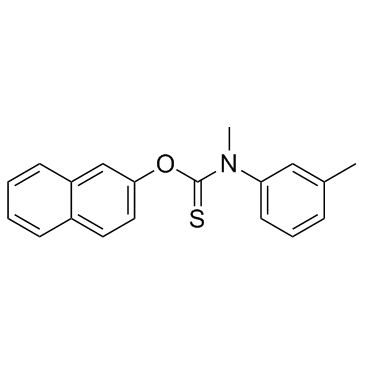Study on the supramolecular multirecognition mechanism of beta-naphthol/beta-cyclodextrin/anionic surfactant in a tolnaftate hydrolysis system.
Tang Bo, Wang Xu, Wang Jing, Yu Chengguang, Chen Zhenzhen, Ding Yi
Index: J. Phys. Chem. B 110(17) , 8877-84, (2006)
Full Text: HTML
Abstract
Based on the fact that tolnaftate degrade to beta-naphthol sodium (RONa) at 5.00 mol/L NaOH solution and RO(-) was protonated to ROH after being acidified and adjusted to the pH 4.50 by acetic acid-sodium acetate buffer solution, we studied and discussed the mechanism of the supramolecular multirecognition interaction among the anionic surfactants sodium lauryl sulfate (SLS), beta-cyclodextrin (beta-CD), and beta-naphthol (ROH) by means of fluorescence spectrum, surface tension of the solution, infrared spectrograms, and (1)HNMR spectroscopy. The apparent formation constant of the ternary inclusion complex was determined to be (5.48 +/- 0.13) x 10(3) L(2)/mol(2). The thermodynamic parameters (DeltaG degrees, DeltaH degrees, DeltaS degrees ) for the formation of the inclusion complexes were obtained from the van't Hoff equation. It was indicated that the multiple and synergistic protection effect of SLS and beta-CD on the excited singlet state ROH played very important roles in the enhancement of the fluorescence of ROH. Results showed that, at room temperature, the naphthalene ring of ROH and the hydrophobic hydrocarbon chain of SLS were included into the cavity of beta-CD to form a ROH/SLS/beta-CD ternary inclusion complex with stoichiometry of 1:1:1, which provided effective protection for the excited state of ROH and increased the fluorescent intensity of ROH obviously.
Related Compounds
| Structure | Name/CAS No. | Molecular Formula | Articles |
|---|---|---|---|
 |
tolnaftate
CAS:2398-96-1 |
C19H17NOS |
|
Characterization of iprodione resistance in Botrytis cinerea...
2014-04-01 [Phytopathology 104(4) , 396-402, (2014)] |
|
DrugBank 3.0: a comprehensive resource for 'omics' research ...
2011-01-01 [Nucleic Acids Res. 39 , D1035-41., (2011)] |
|
A randomised controlled trial of active chronic otitis media...
2012-08-01 [Clin. Otolaryngol. 37(4) , 261-70, (2012)] |
|
X-ray powder diffractometric method for quantitation of crys...
2002-04-01 [J. Pharm. Sci. 91(4) , 983-90, (2002)] |
|
Studies on the mode of action of tolnaftate in Microsporum g...
1991-01-01 [J. Med. Vet. Mycol. 29(1) , 45-52, (1991)] |